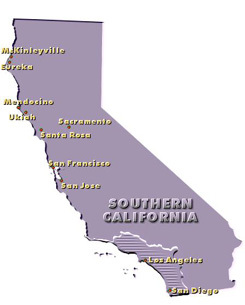
- Capital City:
- Sacramento
- Nickname:
- The Golden State
- Motto:
- Eureka (I have found it)
- Statehood:
- September 9, 1850 (31st)
- Origin of State's Name:
- Named by the Spanish after Califia, a mythical paradise in a Spanish romance written by Montalvo in 1510.
- Largest Cities:
- Los Angeles, San Diego, San Jose, San Francisco, Long Beach
- Border States:
- Arizona, Nevada, Oregon
- Land Area:
- 155,973 sq. mi.; 3rd largest
- State Bird:
- California Valley Quail
- State Flower:
- Golden Poppy (eschscholtzia californica)
- State Tree:
- California redwood (sequoia sempervirens)
- State Song:
- I Love You, California
Nicknamed the "Golden State," California is the third largest state in area after Alaska and Texas. The discovery of gold and the immigration in 1849 of thousands of "forty-niners" in search of the precious metal helped California's admission into the Union in 1850. Today, California, land of the giant redwoods, has the highest population of any state in the nation and is America's principal agricultural state. It is also the home of Hollywood, the center of America's movie and television industry. Its capital is Sacramento and the state flower is the golden poppy.
Old Spanish Days in Santa Barbara
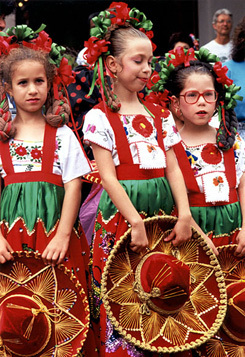
Have you ever been to a real, authentic fiesta? Every year in August, the city of Santa Barbara celebrates its Mexican roots with the Old Spanish Days Fiesta. This community festival, first held in 1924, celebrates the Rancho Period (1830-1865) of Santa Barbara's history. This period spanned the time when Santa Barbara was under both Mexican (1822-1848) and American rule (1848+). At the time, Santa Barbara was a remote rural area under the influence of Spanish, Mexican, and local Chumash Indian cultures.
The name "rancho" refers to the cattle ranches (ranchos) that were established when the Mexican governor distributed large areas of California land to people of influence. The rancheros (ranch owners) might hire as many as 100 workers to work on the ranchos. Usually the workers were Chumash Indians who had been trained at the Catholic missions. The Indians worked as vaqueros, usually with a foreman called a mayordomo (pronounced my-or-DOE-moe). Others worked as harness makers, tanners and carpenters.
Santa Barbara celebrates the traditions of the California Rancho Period at the Old Spanish Days Fiesta with music and dancing, open-air marketplaces with traditional California-Mexican foods, flower girls who hand out hundreds of flowers, and four days of rodeo events.
California Strawberry Festival
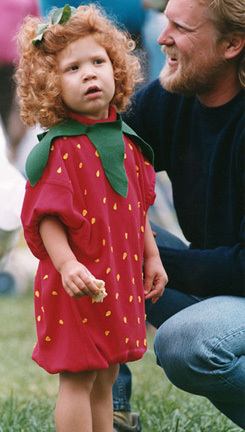
Have you ever tried a strawberry pizza? If you went to Oxnard, the "Strawberry Capital of California," in May, you could!
Oxnard is in Southern California and this part of the state takes its strawberries very seriously. At the two-day California Strawberry Festival you can sample strawberries prepared in all sorts of ways. In addition to traditional treats such as strawberry shortcake, strawberry jam, strawberry tarts and strawberries dipped in chocolate, there is strawberry pizza! This dessert pizza is topped with strawberries, sour cream, cream cheese and whipped cream on a sweet bread baked like a pizza. Strawberry kabobs dipped in powdered sugar are another delicacy. And drinks such as a strawberry smoothie can wash it all down.
Strawberries are big business in Oxnard. The annual strawberry revenues are $100 million from Oxnard's bountiful 6,600 berry acres. Twenty-four companies harvest and cool nearly 16 million trays of berries, which are shipped throughout North America as well as to Germany and Japan. The festival, which attracts more than 85,000 visitors, features three stages with musical entertainment, 335 arts and crafts exhibits, strolling musicians, clowns, artists, face-painting, contests, and a "Strawberryland" for children with puppets, magicians, musicians, and a petting zoo.
Surfing
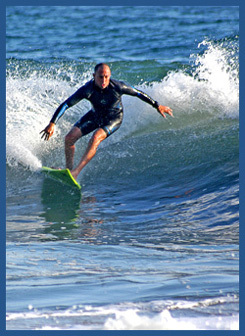
"Commemorating the ageless quest for the perfect wave," the Huntington Beach International Surfing Museum archives materials relating to surfing as both a sport and a lifestyle, including music, art, clothing, and film. With its eight miles of beaches and several major surfing competitions, including the OP Surf Tournament every August, Huntington Beach is a natural for a museum dedicated to surfing. Its local high school even boasts surfing as a varsity sport. The town, known as "Surf City" because of its consistent surf, has been immortalized in the song of the same name by resident Dean Torrance of "Jan & Dean" fame.
Resembling a surfer's dream attic, the museum is a suitably laid-back tribute to the sport's pioneers and the California beach culture that is a worldwide export. Founded by real estate agent Natalie Kotsch in 1989, this tiny 2,000-square-foot museum is the only one in the world officially accredited by the International Surfing Association. The collections include materials on the evolution of the surfboard and the spin-off sports of skateboarding, snowboarding, and windsurfing. The Museum currently has an exhibit of surfing music, and on Sunday afternoons from 1 to 3 has live surfing music in its outdoors "Black Bottom Room," aka "the parking lot." Included among the Museum's exhibits have been Women in Surfing - 1920-1980; Evolution of the Skateboard; Hole in the Wall Gang - Circa 1960; Endless Summer - Bruce Brown, Robert August; and History of Surf Lifesaving.
Project materials include a history of the International Surfing Museum, a photograph, a newspaper article, a flyer, a membership brochure, and copies of Shorebreak, the Museum's newsletter.
Historic Walk of Los Pobladores
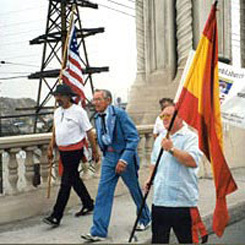
Each year over the Labor Day Weekend, the cities of San Gabriel and Los Angeles shared history and culture come alive through the "Los Pobladores Historic Walk to Los Angeles." The Walk is a historic reenactment of the 1781 nine-mile walk of the original Spanish settlers ( Los Pobladores) from San Gabriel Mission to present-day Los Angeles (El Pueblo de la Reina de Los Angeles - the City of the Queen of Angels), which they founded 218 years ago. The tradition of the walk was begun in 1981 by T. Willard Hunter, a Claremont, California, columnist and administrator, and descendants of the original founders of the city, who had organized themselves on the 200th anniversary of the founding of Los Angeles in 1981 to become Los Pobladores 200.
Following three-days of festivities celebrating the founding of the San Gabriel Mission in 1771, the Walk is the kickoff ceremony which begins Los Angeles' birthday celebration and honors San Gabriel's place in history as the "Birthplace of the Los Angeles Region." The nine-mile walk begins at 6:00 a.m. and takes approximately three hours to complete. At the end of their nine-mile trek, walkers are greeted with a warm Los Angeles welcome and enjoy dramatic presentations and other activities at the Plaza of Los Angeles. Over the years, participation has grown to include local, district and state officials, dignitaries, history and culture lovers, and people from all walks of life, ethnicities, and backgrounds.
Included in the project is a seven-page report; 13 color snapshots with descriptions; a press release; newspaper articles; City of San Gabriel information materials; four flyers, a "certificate of participation" for walkers, and a map of the walk route.
San Bruno Posy Parade
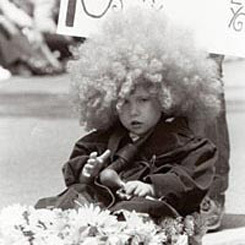
The flower-decked floats and entries in this children's parade were judged on how they best represented the theme chosen for that year. The oldest children's parade in the United States, it was first held in 1941 as a "festival of flowers" dedicated to children. Patterned after the famous Tournament of Roses Parade in Pasadena, this parade was advertised as "The Tournament of Posies Parade." Eighty children marched in the first parade. Any child could enter and march as long as flowers predominated in the decoration of their tricycles, buggies, pets, etc. The paraders were grouped into "divisions." Division 1 included wagons, wheelbarrows, or carts that were pushed or pulled. Division 2 was tricycles, scooters, non-motorized "autos," velocipedes or wheeled toys, excluding bicycles. Division 3 was for doll or baby carriages. Division 4 was for "unique or original ideas." Division 5 was only for bicycles, and Division 6 was floats from children's organizations. No motorized vehicles were permitted. Beginning in 1944, a San Bruno schoolgirl was selected as Parade Princess, accompanied by a "court" of other young girls, all dressed in finery and flowers. In 1945, the Posy Parade Ball was inaugurated as a fund-raiser.
In 1989, the 49th Posy Parade became the focal point of San Bruno 75th anniversary. But in 1991, a seemingly innocuous change in the parade's divisions significantly altered the look and success of future parades. Division 1 became "Baseball," and later simply "Sports" (teams). Teams are allowed to march without any kind of floral decoration, so, by the end of the decade, the parade had deteriorated into dozens of sports teams, marching in uniform. By 1999, there were only three decorated carriage/buggy entries and only two cart/wagon entries. Other factors have also contributed to the Parade's decline: the urbanization of San Bruno, once a primarily rural community; working mothers with less time to devote to such a social event; the continued decline in support of local businesses. The parade was carried on in the 1990s: a princess and her court are still selected; the mayor still rides in a snorkel fire truck, a few bands march, as do the ubiquitous sports teams. But the parade does not have the flair nor the crowds of days gone by. Still, it is the city's unique claim to fame, and it is hoped that the tradition will survive.
Included in the project documentation are a 21-page history of the event, photos of the Parade with accompanying descriptions, a roster of the Posy Parade Princesses, Posy Parade ephemera (copies of newspaper articles, flyers, promotional materials), and a videotape of Posy Parade highlights (1963, 1997, 1998, and 1999).
California Relocation
If your are considering relocating to California, this California Relocation Guide will give you essential information on Schools, Voting, Drivers License,real estate, etc.
 Print
Print Email
Email







